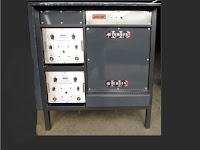 |
| Coal fired power plants must manage fly ash properly. |
As the hot fly ash cools, condensate on the hopper walls can form. The mixture of dry, sulfur rich fly ash and water is very problematic, so it's very important to keep condensation from forming in the collection hoppers. The mixture of water and fly ash can cause clogging (or “pluggage”) in the throat of the hopper, and more importantly, the residual sulphur in the flue gas will combine with the condensate to form sulphuric acid. The suluric acid attacks the hopper walls from the inside causing corrosion, weakening the walls and creating significant (and costly) maintenance issues over time.
 |
| Fly ash hopper with heaters. |
The evacuation and management of fly ash is much easier when the ash is kept hot. One of the most common ways to maintain elevated fly ash and hopper temperature are electric hopper heaters attached to the external hopper walls. Hopper heaters play a very important role in the removal of fly ash from precipitators and bag filter hoppers by keeping the hopper temperatures operating above the flue gas acid dew point. The hopper heater’s sole function is to preheat the hopper and the internal environment to prevent the formation of moisture and the resulting clumping of fly ash and development of sulphuric acid.
 |
| Flexible heating element used on hopper throat. |
The use of electric hopper heaters on electrostatic precipitator and bag house fly ash collection systems is a time proven, effective way to prevent condensate formation and the resulting clumping and corrosive acids in hoppers, thus facilitating a better opportunity for uninterrupted fly ash production.
For more information, contact:
2960 East State Street Ext.
Hamilton, NJ 08619
Phone # 609.588.0900
Fax # 609.588.8333
Email: dap@hotfoilehs.com
www.hotfoilehs.com





